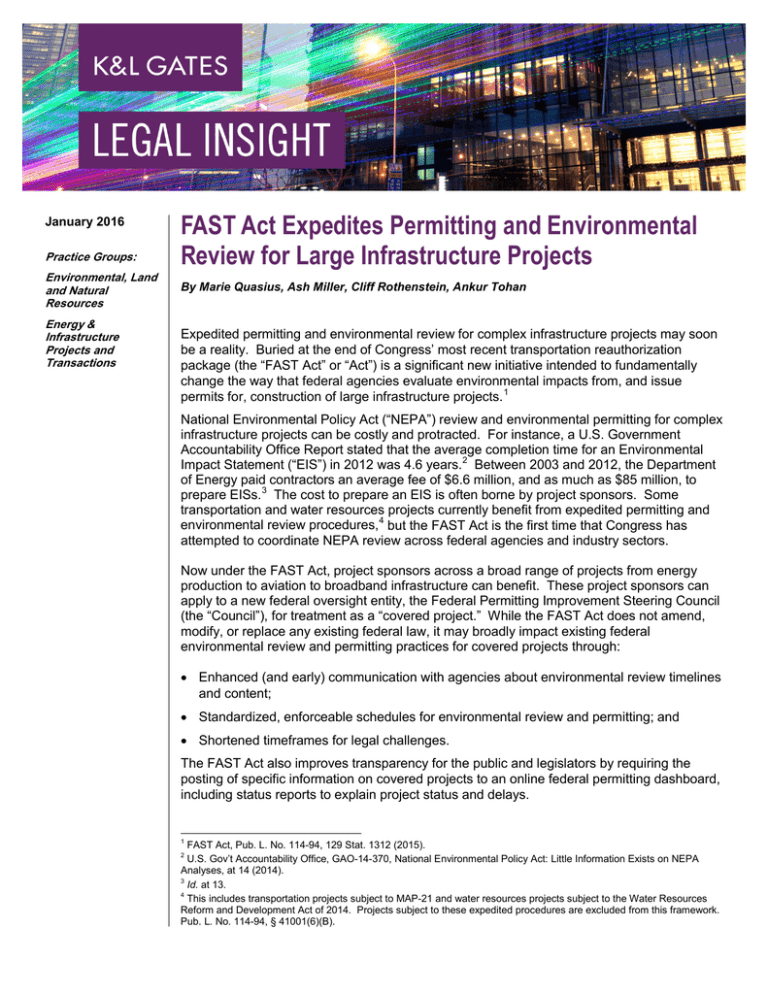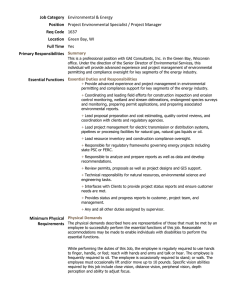FAST Act Expedites Permitting and Environmental Review for Large Infrastructure Projects
advertisement

January 2016 Practice Groups: Environmental, Land and Natural Resources Energy & Infrastructure Projects and Transactions FAST Act Expedites Permitting and Environmental Review for Large Infrastructure Projects By Marie Quasius, Ash Miller, Cliff Rothenstein, Ankur Tohan Expedited permitting and environmental review for complex infrastructure projects may soon be a reality. Buried at the end of Congress’ most recent transportation reauthorization package (the “FAST Act” or “Act”) is a significant new initiative intended to fundamentally change the way that federal agencies evaluate environmental impacts from, and issue permits for, construction of large infrastructure projects. 1 National Environmental Policy Act (“NEPA”) review and environmental permitting for complex infrastructure projects can be costly and protracted. For instance, a U.S. Government Accountability Office Report stated that the average completion time for an Environmental Impact Statement (“EIS”) in 2012 was 4.6 years.2 Between 2003 and 2012, the Department of Energy paid contractors an average fee of $6.6 million, and as much as $85 million, to prepare EISs.3 The cost to prepare an EIS is often borne by project sponsors. Some transportation and water resources projects currently benefit from expedited permitting and environmental review procedures,4 but the FAST Act is the first time that Congress has attempted to coordinate NEPA review across federal agencies and industry sectors. Now under the FAST Act, project sponsors across a broad range of projects from energy production to aviation to broadband infrastructure can benefit. These project sponsors can apply to a new federal oversight entity, the Federal Permitting Improvement Steering Council (the “Council”), for treatment as a “covered project.” While the FAST Act does not amend, modify, or replace any existing federal law, it may broadly impact existing federal environmental review and permitting practices for covered projects through: • Enhanced (and early) communication with agencies about environmental review timelines and content; • Standardized, enforceable schedules for environmental review and permitting; and • Shortened timeframes for legal challenges. The FAST Act also improves transparency for the public and legislators by requiring the posting of specific information on covered projects to an online federal permitting dashboard, including status reports to explain project status and delays. 1 FAST Act, Pub. L. No. 114-94, 129 Stat. 1312 (2015). U.S. Gov’t Accountability Office, GAO-14-370, National Environmental Policy Act: Little Information Exists on NEPA Analyses, at 14 (2014). 3 Id. at 13. 4 This includes transportation projects subject to MAP-21 and water resources projects subject to the Water Resources Reform and Development Act of 2014. Projects subject to these expedited procedures are excluded from this framework. Pub. L. No. 114-94, § 41001(6)(B). 2 FAST Act Expedites Permitting and Environmental Review for Large Infrastructure Projects FAST Act Framework The FAST Act applies to a broad range of sectors, including: • Conventional Energy Production • Renewable Energy Production • Pipelines • Ports and Waterways • Water Resource Projects • Electricity Transmission • Surface Transportation • Manufacturing • Broadband • Aviation However, this list is nonexclusive, because any project may qualify as a covered project if it is subject to NEPA and either (a) is likely to require a total investment of more than $200 million and does not qualify for “abbreviated authorization or environmental review processes under any applicable law,” or (b) the size and complexity of the project (in the opinion of the Council) make it likely to benefit from enhanced oversight and coordination (e.g., due to preparation of an EIS or authorizations or environmental review by more than two federal agencies). 5 The Council and its Executive Director (who will be nominated by the President) includes representatives from several federal agencies.6 The Council bears the responsibility for establishing an inventory of covered projects that are pending environmental review or authorization by any federal agency. 7 While project sponsors can suggest that their project should be included by submitting a notice of initiation, 8 designation of a project is subject to a majority vote of the Council.9 Once designated as a covered project, each project must have an entry on the Permitting Dashboard (the “Dashboard”) 10 that includes the notice of initiation, the application and supporting documents for any environmental review or authorization (or directions on how to access such documents), any agency action or decision that materially affects the status of the project, any significant document supporting such action or decision, and the status of any litigation to which the agency is a party that is 5 Pub. L. No. 114-94, § 41001(6)(A). This includes representatives designated by the Secretaries of Agriculture, the Army, Commerce, Interior, Energy, Transportation, Defense, Homeland Security, and Housing and Urban Development; the Administrator of the Environmental Protection Agency; and the Chairperson of the Federal Energy Regulatory Commission, Nuclear Regulatory Commission, and the Advisory Council on Historic Preservation. Pub. L. No. 114-94, § 41002(a)(2)(B). 7 Pub. L. No. 114-94, § 41002(c)(1)(A). 8 Pub. L. No. 114-94, § 41003(1)(A). 9 Pub. L. No. 114-94, § 41001(6)(A). 10 Pub. L. No. 114-94, § 41003(b)(2)(A). 6 2 FAST Act Expedites Permitting and Environmental Review for Large Infrastructure Projects directly related to the project (including any judicial document available on a federal, state, or local electronic docket). 11 By December 2016, the Council must categorize the projects in the inventory by sector and develop recommended performance schedules for environmental reviews and authorizations most commonly required for that category. 12 The final completion date in the recommended performance schedule for each category cannot exceed the average time to complete environmental review and permitting for projects within that category (as calculated between the filing of a completed application and final agency action). 13 Agencies must issue decisions on environmental review or authorizations not later than 180 days after the date on which all necessary information is in the agency’s possession.14 Implications for Individual Projects In addition to its information-gathering and publication functions, the FAST Act offers particular benefits for individual projects, including early consultation to identify necessary permits and information and an enforceable schedule for environmental review and permitting. Within 60 days after the project is required to be added to the Dashboard, the facilitating or lead agency must identify agencies that intend to exercise authority over the project and, in consultation with the coordinating and participating agencies, must develop a plan for coordinating public and agency participation in, and completion of, any required federal environmental review and authorization. 15 This plan must include a comprehensive schedule with deadlines for all federal environmental reviews and authorizations and, to the maximum extent practicable, state reviews and authorizations. 16 The permitting timetable generally must follow the performance schedules established for the applicable category of the project, but may vary. 17 Once a schedule is established, each federal agency is required to conform to the completion date set forth in the permitting timetable.18 Changes to the timetable are limited and require justification along with consultation from key stakeholders. For example, for a timetable modification that would extend the final completion date by more than 30 days, the facilitating or lead agency can only modify the schedule with the agreement of the affected cooperating agencies, a written justification, and the approval of the Executive Director in consultation with the project sponsor. 19 In addition, the total length of all modifications to the permitting schedule may not extend the permitting timetable for a 11 Pub. L. No. 114-94, § 41003(b)(3)(A). Pub. L. No. 114-94, § 41002(c)(1). 13 Pub. L. No. 114-94, § 41002(c)(1)(C)(ii)(II)(aa), (bb). 14 Pub. L. No. 114-94, § 41002(c)(1)(C)(ii)(II)(cc). 15 Pub. L. No. 114-94, § 41003(c)(1), (2). 16 Id. 17 These factors include the project’s size and complexity, the resources available to the participating agencies, the regional or national economic significance of the project, the sensitivity of the natural or historic resources that may be affected by the project, the financing plan, and precedent for similar projects in geographic proximity. Pub. L. No. 114-94, § 41003(c)(2)(B). 18 Pub. L. No. 114-94, § 41003(c)(1)(F). 19 Pub. L. No. 114-94, § 41003(c)(1)(D)(i). 12 3 FAST Act Expedites Permitting and Environmental Review for Large Infrastructure Projects period greater than half the amount of time originally allotted to environmental review and permitting unless the Office of Management and Budget specifically approves such modification and sends a report to Congress explaining why modification is required.20 If an agency fails to meet a deadline, the agency must promptly submit to the Executive Director (for posting on the Dashboard) an explanation for this failure and a proposal for an alternative deadline, followed by monthly status reports to the Executive Director until the agency takes the required action.21 Coordination with States and Interstate Compacts; NEPA Alternatives Analysis The FAST Act also contains innovative provisions on coordination of state environmental review with the federal NEPA process. In addition to NEPA, several states, including New York, California, and Washington, have state statutes that impose state-level environmental impact review. For large projects, these state reviews often run in parallel with the federal process but can extend for a longer timeframe or be sequential. The FAST Act now requires that state and federal reviews run concurrently for a covered project as long as it does not impair a federal agency’s ability to review the project. This gives project proponents some assurance that they will not be subject to lengthy, and likely duplicative, sequential state and federal reviews. Some states allow state reviews to piggyback on the NEPA process via adoption or supplementation of a NEPA EIS to meet state law requirements. The FAST Act allows the opposite to occur: i.e., allowing a state review process to demonstrate compliance with NEPA. A state-level EIS to meet NEPA may be a more efficient process than NEPA. Accordingly, the FAST Act process would eliminate the extra step that is usually required now, whereby a state agency would adopt a NEPA review but supplement the review to meet broader state law requirements. The FAST Act encourages that coordination processes among state agencies, federal agencies, and tribes be memorialized via a memorandum of understanding. In addition, the FAST Act authorizes the formation of interstate compact entities to encourage regional infrastructure development. The extent of authority vested in such entities is not clear under the Act, but the intent is to allow the entity to facilitate authorization and environmental review of covered projects or exercise permitting authority delegated under a federal program. The FAST Act also contemplates development of best practices for state-level permitting timelines where a state is exercising delegated federal-permitting authority. The FAST Act includes provisions impacting analysis and selection of alternatives for covered projects. The range of alternatives for analysis must be chosen before the end of scoping. Analysis for non-preferred alternatives may be less detailed. In practice, given the FAST Act’s objective to expedite review, this provision may exempt lead agencies from considering new alternatives raised during public comment on a draft EIS. It also provides a legal basis for discussing the preferred alternative in detail but leaving other alternatives at a more conceptual level of analysis. 20 21 Pub. L. No. 114-94, § 41003(c)(1)(D)(iii). Pub. L. No. 114-94, § 41003(b)(2)(F)(ii). 4 FAST Act Expedites Permitting and Environmental Review for Large Infrastructure Projects Opportunities for Judicial Review The Act contains limitations on judicial review to protect approved projects from legal challenges. In a strong, new provision of law, challenges to covered projects under federal law are barred two years after a final permit decision. Current law is less clear, but can extend a claim up to six years. NEPA challenges are limited to those persons who commented on an EIS and issues raised with sufficient detail to put the lead agency on notice of the claims. In the context of claims for injunctive relief of an approved project, the Act requires courts to consider the impact on public health, safety, and the environment, in addition to “the potential for significant negative effects on jobs.” 22 While the FAST Act imposes deadlines on permitting and environmental review, the enforceability of those deadlines in court is not as clear. The Act requires a timeline to be set for completion dates on agency action for a covered project, and this duty is mandatory, i.e., the Act states that “each agency shall conform” to these dates. However, the Act further provides for specific next steps in the event that the schedule is not met by an agency; the consequences for failure to act on a project is to publish “an explanation of the specific reasons for failing or significantly risking failing to conform to the completion date and a proposal for an alternative completion date,” and monthly updates thereafter. 23 The Act also gives agencies a degree of discretion in determining when they have sufficient information to make a decision on a project, and issuance of a final decision must occur no later than 180 days thereafter.24 Thus, there may be some discretion embedded in the time limit should an agency determine more information is needed. Therefore, it is not clear whether Congress intended the schedule to be a mandatory, nondiscretionary duty that would be subject to potential injunctive relief in federal court. To the extent disputes arise about the process of environmental review, including the choice of facilitating agency and the timeline itself, the Act provides expedited dispute resolution processes, allowing the Council on Environmental Quality to decide a facilitating agency, and the Office of Management and Budget to decide timeline disputes. 25 The Act provides that timeline disputes are not subject to judicial review but contains no similar provision for designation of facilitating agency. Conclusion The FAST Act presents a significant opportunity for proponents of large infrastructure projects to increase certainty on environmental review timelines and to raise their profile for purposes of seeking attention and resources of federal agencies. While the process will not provide certainties as to permitting decisions, it likely will significantly reduce the risk of undue delays by increasing applicants’ leverage, providing additional oversight for agency review, and thereby encouraging expeditious and efficient reviews. 22 Pub. L. No. 114-94, § 41007(b). Pub. L. No. 114-94, § 41007(c)(2)(f). 24 Pub. L. No. 114-94, § 41002(c)(1)(A)(ii)(II)(cc). 25 Pub. L. No. 114-94, § 41007(a)(6)(B); (c)(2)(C)(ii). 23 5 FAST Act Expedites Permitting and Environmental Review for Large Infrastructure Projects Authors: Marie E. Quasius Marie.Quasius@klgates.com +1. 206.370.8195 Ash Miller ash.miller@klgates.com +1. 206.370.7962 Cliff L. Rothenstein cliff.rothenstein@klgates.com +1. 202.778.9381 Ankur K. Tohan ankur.tohan@klgates.com +1. 206.370.7658 Anchorage Austin Fort Worth Frankfurt Orange County Beijing Berlin Harrisburg Palo Alto Paris Boston Hong Kong Perth Brisbane Houston Pittsburgh Brussels London Portland Charleston Los Angeles Raleigh Charlotte Melbourne Research Triangle Park Chicago Miami Dallas Milan San Francisco Doha Newark Dubai New York São Paulo Seattle Seoul Shanghai Singapore Sydney Taipei Tokyo Warsaw Washington, D.C. Wilmington K&L Gates comprises approximately 2,000 lawyers globally who practice in fully integrated offices located on five continents. The firm represents leading multinational corporations, growth and middle-market companies, capital markets participants and entrepreneurs in every major industry group as well as public sector entities, educational institutions, philanthropic organizations and individuals. For more information about K&L Gates or its locations, practices and registrations, visit www.klgates.com. This publication is for informational purposes and does not contain or convey legal advice. The information herein should not be used or relied upon in regard to any particular facts or circumstances without first consulting a lawyer. © 2016 K&L Gates LLP. All Rights Reserved. 6






